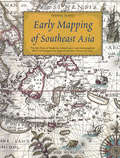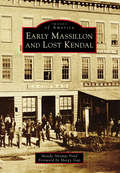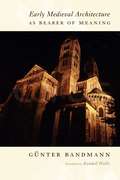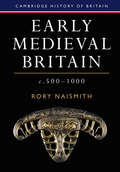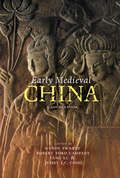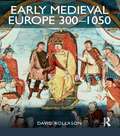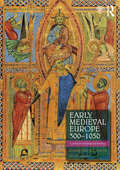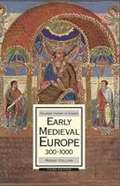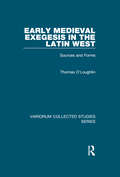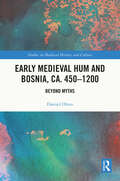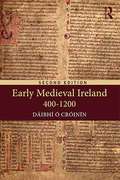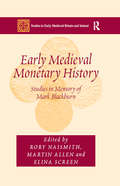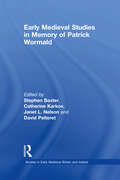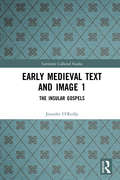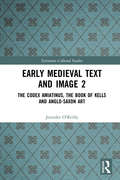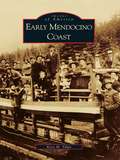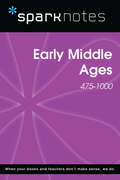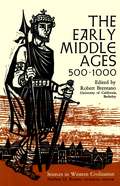- Table View
- List View
Early Mapping of Southeast Asia
by Thomas SuarezEarly Mapping of Southeast Asia follows the story of mapmaking, exploration and colonization in Asia from the 16th to the 19th centuries. It surveys Southeast Asia's geography and civilizations, its maps and their influence on Western worldviews, as well as the image of Southeast Asia in the eyes of its neighbors.
Early Mapping of Southeast Asia
by Thomas SuarezEarly Mapping of Southeast Asia follows the story of mapmaking, exploration and colonization in Asia from the 16th to the 19th centuries. It surveys Southeast Asia's geography and civilizations, its maps and their influence on Western worldviews, as well as the image of Southeast Asia in the eyes of its neighbors.
Early Mapping of the Pacific
by Thomas Suárez290 full-color and b&w maps and early prints. Fully illustrated history of the Pacific Ocean from Portuguese mariners to 20th centuy explorers that includes a cornucopia of rare and beautiful maps of the Pacific Ocean, in particular, Hawaii, Tahiti, Australia, and New Zealand, among other Pacific Islands and territories. The text traces the exploration, and charting of the great ocean, and follows the story from classical times through the turn of the 20th century, telling the tales of seafarers who ventured eastward from Asia and were the Pacific's greatest explorers.
Early Mapping of the Pacific
by Thomas Suárez290 full-color and b&w maps and early prints. Fully illustrated history of the Pacific Ocean from Portuguese mariners to 20th centuy explorers that includes a cornucopia of rare and beautiful maps of the Pacific Ocean, in particular, Hawaii, Tahiti, Australia, and New Zealand, among other Pacific Islands and territories. The text traces the exploration, and charting of the great ocean, and follows the story from classical times through the turn of the 20th century, telling the tales of seafarers who ventured eastward from Asia and were the Pacific's greatest explorers.
Early Massillon and Lost Kendal (Images of America)
by Mandy Altimus Pond Margy VogtBefore Massillon, there was Kendal, Ohio. The story of these communities is a tapestry of local, national, and international history. Referencing new archival discoveries in the Massillon Museum, Spring Hill Historic Home, and Massillon Public Library collections, this book tells stories of early Kendal and Massillon, shedding light on the Ohio frontier and its pioneers from 1812 to 1860. Kendal was founded in 1812 by Thomas and Charity Rotch, prominent Quakers from powerful New England whaling families. Kendal became an Owenite utopian socialistic community between 1826 and 1829, visited by Robert Owen himself. In 1826, James Duncan founded Massillon, bordering the Tuscarawas River, the boundary between the United States and Indian Territory. Massillon attracted inventors such as photographic pioneer Abel Fletcher, who invented the paper negative in his South Erie Street studio. Both Kendal and Massillon were hubs for Underground Railroad activities.
Early Medieval Architecture as Bearer of Meaning
by Kendall Wallis Bandmann GünterThis classic text -- continually in print for more than half a century -- analyzes the architecture of societies in western Europe up to the twelfth century that aspired to be the heirs to the Roman Empire.
Early Medieval Architecture as Bearer of Meaning
by Gunter BandmannAt last available in English, this classic text was originally published in Germany in 1951 and has been continuously in print since then. Gunter Bandmann analyzes the architecture of societies in western Europe up to the twelfth century that aspired to be the heirs to the Roman Empire. He examines the occurrence and recurrence of basic forms not as stylistic evolutions but as meaningful expressions of meta-material content and develops an architectural iconography of symbolic, historical, and aesthetic elements.
Early Medieval Britain, c. 500–1000 (Cambridge History of Britain #1)
by Rory NaismithEarly medieval Britain saw the birth of England, Scotland and of the Welsh kingdoms. Naismith's introductory textbook explores the period between the end of Roman rule and the eve of the Norman Conquest, blending an engaging narrative with clear explanations of key themes and sources. Using extensive illustrations, maps and selections from primary sources, students will examine the island as a collective entity, comparing political histories and institutions as well as societies, beliefs and economies. Each chapter foregrounds questions of identity and the meaning of 'Britain' in this period, encouraging interrogation and contextualisation of sources within the framework of the latest debates and problems. Featuring online resources including timelines, a glossary, end-of-chapter questions and suggestions for further reading, students can drive their own understanding of how the polities and societies of early medieval Britain fitted together and into the wider world, and firmly grasp the formative stages of British history.
Early Medieval China
by Wendy Swartz Yang Lu Robert Ford Campany Jessey J. ChooThis innovative sourcebook builds a dynamic understanding of China's early medieval period (220-589) through an original selection and arrangement of literary, historical, religious, and critical texts. A tumultuous and formative era, these centuries saw the longest stretch of political fragmentation in China's imperial history, resulting in new ethnic configurations, the rise of powerful clans, and a pervasive divide between north and south.Deploying thematic categories, the editors sketch the period in a novel way for students and, by featuring many texts translated into English for the first time, recast the era for specialists. Thematic topics include regional definitions and tensions, governing mechanisms and social reality, ideas of self and other, relations with the unseen world, everyday life, and cultural concepts. Within each section, the editors and translators introduce the selected texts and provide critical commentary on their historical significance, along with suggestions for further reading and research.
Early Medieval China: A Sourcebook (Suny Series In Chinese Philosophy And Culture Ser.)
by Wendy Yang Lu Robert Ford Campany Eds. Swartz Jessey J. C. ChooThis innovative sourcebook builds a dynamic understanding of China's early medieval period (220–589) through an original selection and arrangement of literary, historical, religious, and critical texts. A tumultuous and formative era, these centuries saw the longest stretch of political fragmentation in China's imperial history, resulting in new ethnic configurations, the rise of powerful clans, and a pervasive divide between north and south. Deploying thematic categories, the editors sketch the period in a novel way for students and, by featuring many texts translated into English for the first time, recast the era for specialists. Thematic topics include regional definitions and tensions, governing mechanisms and social reality, ideas of self and other, relations with the unseen world, everyday life, and cultural concepts. Within each section, the editors and translators introduce the selected texts and provide critical commentary on their historical significance, along with suggestions for further reading and research.
Early Medieval Europe 300-1050: The Birth of Western Society
by David RollasonThe centuries following the collapse of the Roman Empire saw extraordinary change across Western Europe - in institutions, social structure, rural and urban life, religion, learning, scholarship and art. This innovative textbook provides students coming to the study of Early Medieval Europe for the first time with the conceptual and methodological tools to investigate the period for themselves. It identifies major research questions and historiographical debates and offers guidance on how to engage with and evaluate the major documentary sources and the evidence of art history and archaeology. Ideally structured to support courses and classes in Medieval European history, the book's features include: Over 50 carefully selected maps and illustrations accompanied by explanatory commentary Detailed guidance on further reading with research questions to aid understanding Timelines and maps to orientate the reader in each chapter An extensive companion website providing practical study guidance, reference materials and access to further primary sources Offering a road map to the rich written and non-written sources for this period, and the exciting recent scholarship, this book is an essential guide for any student wishing to gain a deeper level of understanding and greater confidence in creative and independent historical thought.
Early Medieval Europe 300–1050: A Guide for Studying and Teaching
by David RollasonEarly Medieval Europe 300–1050: A Guide for Studying and Teaching empowers students by providing them with the conceptual and methodological tools to investigate the period. Throughout the book, major research questions and historiographical debates are identified and guidance is given on how to engage with and evaluate key documentary sources as well as artistic and archaeological evidence. The book’s aim is to engender confidence in creative and independent historical thought. This second edition has been fully revised and expanded and now includes coverage of both Islamic and Byzantine history, surveying and critically examining the often radically different scholarly interpretations relating to them. Also new to this edition is an extensively updated and closely integrated companion website, which has been carefully designed to provide practical guidance to teachers and students, offering a wealth of reference materials and aids to mastering the period, and lighting the way for further exploration of written and non-written sources. Accessibly written and containing over 70 carefully selected maps and images, Early Medieval Europe 300–1050 is an essential resource for students studying this period for the first time, as well as an invaluable aid to university teachers devising and delivering courses and modules on the period.
Early Medieval Europe, 300-1000 (Macmillan History Of Europe Series)
by Roger CollinsIn this classic textbook history of early medieval Europe, Roger Collins provides a succinct account of the centuries during which Europe changed from being an abstract geographical expression to a new culturally coherent, if politically divided, entity. This comprehensive new edition explores key topics such as the fall of the Roman Empire, the rise of both Christianity and Islam, the Vikings, and the expansion of Latin Christian culture into eastern Europe. Clear and insightful, this is an invaluable guide to an important era in the history of both Europe and the wider world. This is an ideal companion for students of History or European Studies taking modules on Early Medieval Europe or Europe in Late Antiquity. In addition, this is a useful reference work for postgraduate students, scholars and teachers of early medieval Europe.
Early Medieval Exegesis in the Latin West: Sources and Forms
by Thomas O'LoughlinOne of the significant developments in scholarship in the latter half of the twentieth century was the awareness among historians of ideas, historians of theology, and medievalists of the importance of the Christian scriptures in the Latin Middle Ages. In contrast to an earlier generation of scholars who considered the medieval period as a ’Bible-free zone’, recent investigations have shown the central role of scripture in literature, art, law, liturgy, and formal religious education. Indeed, to understand the Latin Middle Ages one must understand the value they placed upon the Bible, how they related to it, and how they studied it. However, despite the new emphasis on the Bible’s role and the place of exegesis in medieval thought, our detailed understanding is all too meagre - and generalisations, often imagined as valid for a period of close to a millennium, abound. How the Scriptures were used in one pursuit (formal theology for example relied heavily on ’allegory’) was often very different to the way they were used in another (e.g. in history writing was interested in literal meanings), and exegesis differed over time and with cultures. Similarly, while most medieval writers were agreed that there were several ’senses’ within the text, the number and nature varied greatly as did the strategies for accessing those meanings. This collection of fifteen articles, concentrating on the early Latin middle ages, explores this variety and highlights just how patchy has been our understanding of medieval exegesis. We now may be aware of the importance of the Bible, but the task of studying that phenomenon is in its infancy.
Early Medieval Hum and Bosnia, ca. 450-1200: Beyond Myths (Studies in Medieval History and Culture)
by Danijel DžinoThis book explores social transformations which led to the establishment of medieval Hum (future Herzegovina) and Bosnia in the period from ca. 450 to 1200 AD using the available written and material sources. It follows social and political developments in these historical regions from the last centuries of Late Antiquity, through the social collapse of the seventh and eighth centuries, and into their new medieval beginnings in the ninth century. Fragmentary and problematic sources from this period were, in the past, often used to justify modern political claims to these contested territories and incorporate them into the ‘national biographies’ of the Croats, Serbs and Bosniaks (Bosnian Muslims), or to support the ‘Yugoslavizing’ and other ideological discourses. The book goes beyond ideological and national mythologemes of the past in order to provide a new historical narrative that brings more light to this region placed on the frontiers of both the medieval West and the Byzantine empire. It provides new views of the period between ca. 450 and 1200 for the parts of Western Balkans and Eastern Adriatic, brings the most recent local historical and archaeological research to the Anglophone readership and contributes to the scholarship of the late antique and early medieval Mediterranean study of this very poorly known area. The book is intended for academic audiences interested in history and archaeology of the Late Antiquity and early Middle Ages, but also to all those interested in the general history of Herzegovina, Bosnia, Dalmatia and the Balkans.
Early Medieval Ireland 400-1200 (Longman History Of Ireland Ser.)
by Daibhi O CroininThis impressive survey covers the early history of Ireland from the coming of Christianity to the Norman settlement. Within a broad political framework it explores the nature of Irish society, the spiritual and secular roles of the Church and the extraordinary flowering of Irish culture in the period. Other major themes are Ireland's relations with Britain and continental Europe, the beginnings of Irish feudalism, and the impact of the Viking and Norman invaders. The expanded second edition has been fully updated to take into account the most recent research in the history of Ireland in the early middle ages, including Ireland’s relations with the Later Roman Empire, advances and discoveries in archaeology, and Church Reform in the 11th and 12th centuries. A new opening chapter on early Irish primary sources introduces students to the key written sources that inform our picture of early medieval Ireland, including annals, genealogies and laws. The social, political, religious, legal and institutional background provides the context against which Dáibhí Ó Cróinín describes Ireland’s transformation from a tribal society to a feudal state. It is essential reading for student and specialist alike.
Early Medieval Monetary History: Studies in Memory of Mark Blackburn (Studies in Early Medieval Britain and Ireland)
by Martin AllenMark Blackburn was one of the leading scholars of the numismatics and monetary history of the British Isles and Scandinavia during the early medieval period. He published more than 200 books and articles on the subject, and was instrumental in building bridges between numismatics and associated disciplines, in fostering international communication and cooperation, and in establishing initiatives to record new coin finds. This memorial volume of essays commemorates Mark Blackburn’s considerable achievement and impact on the field, builds on his research and evaluates a vibrant period in the study of early medieval monetary history. Containing a broad range of high-quality research from both established figures and younger scholars, the essays in this volume maintain a tight focus on Europe in the early Middle Ages (6th-12th centuries), reflecting Mark’s primary research interests. In geographical terms the scope of the volume stretches from Spain to the Baltic, with a concentration of papers on the British Isles. As well as a fitting tribute to remarkable scholar, the essays in this collection constitute a major body of research which will be of long-term value to anyone with an interest in the history of early medieval Europe.
Early Medieval Spain: Unity and Diversity, 400-1000
by Roger CollinsThis new edition presents an authoritative account of the history of Spain in the Early Middle Ages.
Early Medieval Studies in Memory of Patrick Wormald (Studies in Early Medieval Britain and Ireland)
by Stephen Baxter Janet L. Nelson Catherine Karkov David PelteretPatrick Wormald was a brilliant interpreter of the Early Middle Ages, whose teaching, writings and generous friendship inspired a generation of historians and students of politics, law, language, literature and religion to focus their attention upon the world of the Anglo-Saxons and the Franks. Leading British, American and continental scholars - his colleagues, friends and pupils - here bear witness to his seminal influence by presenting a collection of studies devoted to the key themes that dominated his work: kingship; law and society; ethnic, religious, national and linguistic identities; the power of images, pictorial or poetic, in shaping political and religious institutions. Closely mirroring the interests of their honorand, the collection not only underlines Patrick Wormald's enormous contribution to the field of Anglo-Saxon studies, but graphically demonstrates his belief that early medieval England and Anglo-Saxon law could only be understood against a background of research into contemporary developments in the nearby Welsh, Scottish, Irish and Frankish kingdoms. He would have been well pleased, therefore, that this volume should make such significant advances in our understanding of the world of Bede, of the dynasty of King Alfred, and also of the workings of English law between the seventh and the twelfth century. Moreover he would have been particularly delighted at the rich comparisons and contrasts with Celtic societies offered here and with the series of fundamental reassessments of aspects of Carolingian Francia. Above all these studies present fundamental reinterpretations, not only of published written sources and their underlying manuscript evidence, but also of the development of some of the dominant ideas of that era. In both their scope and the quality of the scholarship, the collection stands as a fitting tribute to the work and life of Patrick Wormald and his lasting contribution to early medieval studies.
Early Medieval Text and Image Volume 1: The Insular Gospel Books (Variorum Collected Studies)
by Jennifer O'ReillyWhen she died in 2016, Dr Jennifer O’Reilly left behind a body of published and unpublished work in three areas of medieval studies: the iconography of the Gospel Books produced in early medieval Ireland and Anglo-Saxon England; the writings of Bede and his older Irish contemporary, Adomnán of Iona; and the early lives of Thomas Becket. In these three areas she explored the connections between historical texts, artistic images and biblical exegesis. This volume brings together nine studies of the Insular Gospel Books. One of them, on the iconography of the St Gall Gospels (Essay 9), was left completed, but unpublished, on the author’s death. It appears here for the first time. The remaining studies, published between 1987 and 2013, examine certain themes and motifs that inform the Gospel Books: their implicit Christology, their harmonisation of the four Gospel accounts, the depiction of Christ crucified, and the portrayal of St John the Evangelist. Two of the Books, the Durham Gospels and the Gospels of Mael Brigte, receive particular attention.
Early Medieval Text and Image Volume 2: The Codex Amiatinus, the Book of Kells and Anglo-Saxon Art (Variorum Collected Studies)
by Jennifer O'ReillyWhen she died in 2016, Dr Jennifer O’Reilly left behind a body of published and unpublished work in three areas of medieval studies: the iconography of the Gospel Books produced in early medieval Ireland and Anglo-Saxon England; the writings of Bede and his older Irish contemporary, Adomnán of Iona; and the early lives of Thomas Becket. In these three areas she explored the connections between historical texts, artistic images and biblical exegesis. This volume brings together seventeen essays, published between 1984 and 2013, on the interplay of texts and images in medieval art. Most focus on the manuscript art of early medieval Ireland and England. The first section includes four studies of the Codex Amiatinus, produced in Northumbria in the monastic community of Bede. The second section contains seven essays on the iconography and text of the Book of Kells. In the third section there are five studies of Anglo-Saxon Art, examined in the context of the Benedictine Reform. A concluding essay, on the medieval iconography of the two trees in Eden, traces the development of a motif from Late Antiquity to the end of the Middle Ages.
Early Medieval Venice: Cultural Memory and History (Studies in Medieval History and Culture)
by Luigi Andrea BertoEarly Medieval Venice examines the significant changes that Venice underwent between the late-sixth and the early-eleventh centuries. From the periphery of the Byzantine Empire, Venice acquired complete independence and emerged as the major power in the Adriatic area. It also avoided absorption by neighbouring rulers, prevented serious destruction by raiders, and achieved a stable state organization, all the while progressively extending its trading activities to most of northern Italy and the eastern Mediterranean. This was not a linear process, but the Venetians obtained and defended these results with great tenacity, creating the foundations for the remarkable developments of the following centuries. This book presents the most relevant themes that characterized Venice during this epoch, including war, violence, and the manner in which ‘others’ were perceived. It examines how early medieval authors and modern scholars have portrayed this period, and how they were sometimes influenced by their own ‘present’ in their reconstruction of the past.
Early Mendocino Coast
by Katy M. TahjaDriving Highway 1 along the Mendocino coast is a scenic adventure that draws thousands of visitors every year. Following the coast from Gualala on the south to Needle Rock in the north can be a challenge and features back-road driving. But imagine 100 years ago. Were there roads then too? How did people move along the coast? And what were they doing? Why did they settle here? Forget the Gold Rush and the forty-niners--timber was king here. Logging, milling, and shipping wood was the focus of the economy. Railcars steamed through the forests, and ships pulled up to rickety landings to load shipments for faraway places. Today some coast views remain the same, while others have changed dramatically, and whole towns have vanished over the century.
Early Middle Ages (SparkNotes History Notes)
by SparkNotesEarly Middle Ages (475-1000) (SparkNotes History Note) Making the reading experience fun! SparkNotes History Guides help students strengthen their grasp of history by focusing on individual eras or episodes in U.S. or world history. Breaking history up into digestible lessons, the History Guides make it easier for students to see how events, figures, movements, and trends interrelate. SparkNotes History Guides are perfect for high school and college history classes, for students studying for History AP Test or SAT Subject Tests, and simply as general reference tools.Each note contains a general overview of historical context, a concise summary of events, lists of key people and terms, in-depth summary and analysis with timelines, study questions and suggested essay topics, and a 50-question review quiz.
Early Middle Ages, 500-1000
by Robert BrentanoSpanning the years 500 to 1000 A.D., this volume illustrates the conflict between brutality and civilization that seemed to characterize the period so often called—not improperly—the "Dark Ages." Islam and Byzantium, as much as Western Europe, figure in the twenty-two chapters of documents offered in this book, part of the ten-volume series, "Sources of Western Civilization."
